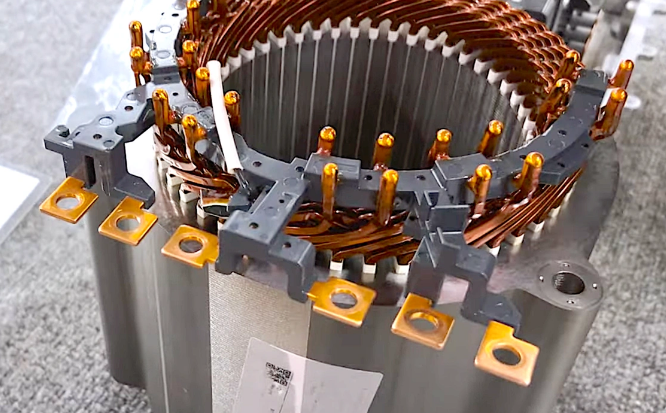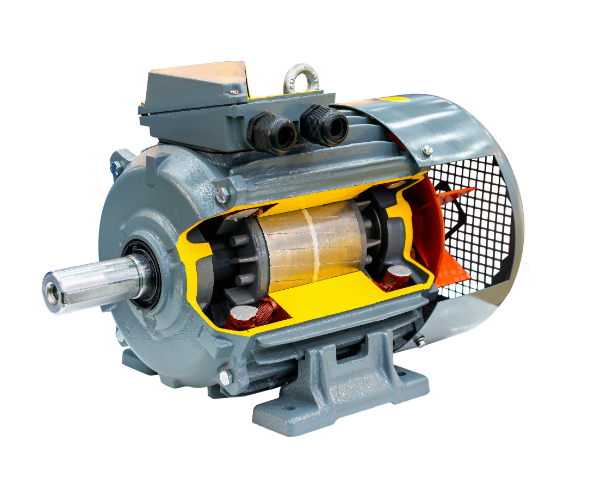The main reasons which answer the question of current difference in each line for a three-phase motor revolve around voltage imbalance, irregular distribution of loads, or winding aging. The solution will be to check on voltage balance, equal load distribution, and regular winding care to make sure the electrical uniformity in their parameters.
Basics of Three-Phase Motors
The three-phase motors are used very effectively in a great number of industrial and commercial sets of equipment due to their high efficiency and stability. A three-phase motor is powered from three power supply lines carrying currents that are out of phase with each other by 120 degrees for each line. Such an arrangement allows the motor to create a rotating magnetic field which drives the rotor uniformly and provides smooth power output. Due to the high power density and efficiency, three-phase motors are theoretically preferred over single-phase motors. Ideally, under perfectly operating conditions, the current on the three-phase motor lines should be completely symmetrical. However, the current on the three-phase motor lines in practical applications is always different. This not only influences the motor operating efficiency but might affect the service life and performance of the equipment.
The work of a three-phase motor, in simple terms, provides an understanding of why the current in each line is behaving differently. A three-phase motor works on the principle of three windings, each with a different current phase by 120 degrees. When three-phase currents run through the windings, a continuous rotating magnetic field is created that actually stirs the rotor inside the motor and electrical energy into mechanical output. If the three-phase voltage is balanced, if the resistances of the windings are equal, and if the motor load is symmetrical, then the three-phase current should, in theory, remain balanced. In practice, however, the characteristics of the motor load, power supply voltage, and the manufacturing of the windings themselves will be certain to make the current on each line unbalanced.
Line Current Analysis
In practice, due to different causes of either electrical or mechanical, one phase current of three-phase motor operation may become unbalanced. Such unbalance may take the form where some lines are drawing higher currents, while others show lower currents. The current imbalance is not a small phenomenon that is to be considered in theoretical analysis; in practical application, it may lead to overheating of the motor, increase in vibration, noise, and even equipment failure.
IEC standards state that if the current imbalance for a three-phase motor exceeds 10%, serious negative effects may occur in the motor and power loss may increase to the square of the percentage of imbalance. When the current imbalance reaches 5%, power losses might go over 10%, which means even smaller imbalances result in big energy losses and heating effects. In addition, the prevailing imbalances may further give rise to the development of local hot spots within the motor windings, which can expedite insulation material aging and, as a result, shorten the life expectancy of the motor.

Causes of Phase Imbalance
Voltage imbalance constitutes the main reason for the inequality in current that takes place in each line feeding a three-phase motor. Ideally, the three-phase voltage supply to the motor must be equal in magnitude, with precisely 120 degrees phase difference. However, owing to the instability of power grids, variations in transformer output, and line voltage drops, it is not possible for three-phase voltage to be always perfectly balanced. This voltage imbalance demands that each winding would carry different currents. Where the voltage on one phase is slightly higher, the current on that line will increase proportionately, while on other lines, lower voltages will demand lower current.
According to the statistics from the National Grid, it is very common to have voltage imbalance happen in the industrial field, especially over long-distance transmission and at a time when the usage of loads is concentrated, or at peak power demand periods. It has been estimated that with every 1% increase in voltage imbalance, as high as 2% of motor efficiency may be reduced. This affects not just the overall energy efficiency of the motors but also results in higher temperature rise during operation, hence shortening the service life of the equipment.
Another major contributor toward phase imbalance is due to the load imbalance. Practically speaking, motors are usually put into the role of driving types of mechanical loads, normally distributed unevenly– thus, asymmetrical three-phase currents. Note this particularly where motors need to drive multi-axis or multi-load devices; an imbalance in the distribution of the loaded would directly affect the current in each line. For example, the workload of various devices linked to some production lines fluctuates at different times, which creates an imbalance in the three-phase load on the motor and, therefore, leads to uneven distribution of current.
Impact of Load Differences
One of the most influential factors that could alter three-phase current balance would be a difference in motor load. The load on a threephase motor incorporates both symmetrical and asymmetrical loads. By symmetrical loads, it means the working condition whereby the three-phase current load of the motor is almost equal and the current of each phase is similar. Asymmetrical loads imply an unequal distribution of load across phases, leading to current imbalances.
In most of the industrial applications, load variations are dynamic. That is to say, the size and nature of the load will change with time. At motor start-up, the load is usually larger and there is a significant inrush current, making the current imbalance more pronounced. After the motor has achieved a stable operating speed, the load decreases progressively, thereby stabilizing the current. Thus, the fluctuations of the load during start-up and operational processes of the motor are considered as one of the principal factors that bring about current imbalance.
The load’s mechanical characteristics serve to alter the current distribution. Whether it be a compressor, pump, or fan that the motor is driving, the type of the load changes from one type of operation condition to another, and thus exerts mechanical resistance and rotational inertia on the motor. It will, at times, unbalance the load between phases and cause the current to be unbalanced. Besides, in several multi-axis driving systems, axes with heavy loads and those with light ones coexist, and unbalanced mechanical load directly acts on the motor’s three-phase current.
This may also be brought about by environmental factors. The friction coefficient and the mechanical resistance of equipment may be altered under conditions of varying temperatures or humidity. In practice, complex loads motor control system normally requires more precise control systems to adapt to the imbalance in load distribution.
Voltage Variation Factors
Voltage fluctuations represent another important factor that influences the balance of the three-phase motor currents. In industrial environments, because of power quality issues, grid voltage undergoes minor or major fluctuations: unstable transformer output, transmission losses while delivering power, voltage drops resulting from transmissions over long distances, or instantaneous surges due to the sudden connections or disconnections of loads.
Voltage fluctuations directly affect the distribution of current in the motor. Ideally, in the case of stable voltage, the current on each line of the motor can keep a balance. However, if the voltage suddenly fluctuates, following Ohm’s law that states current is directly proportional to voltage, a fluctuation in voltage would correspondingly change the current. Where there is a raise of voltage at one phase, the current on that line will also increase, and vice versa. Severe voltage fluctuations over a long time make the motor suffer extra electrical stresses and result in increased temperature of the windings, hence higher risk of failure.
Some industrial fields with high demands take the use of voltage regulators, passive or active filters, and other equipment to ensure that the voltage received by the motor is in an allowed range so as to avoid voltage fluctuations. This equipment will effectively suppress the high-frequency fluctuation and short-term voltage anomaly in the grid and reduce its impact on the balance of motor currents.

Effects of Motor Windings
In three-phase motor, the balance of current largely depends on the design and manufacturing quality of the motor windings. Ideally, the windings of a motor should be symmetrical, meaning resistances, inductions, and mechanical structures are all the same. But in practical production, due to material deviations or problems during manufacturing processes, the windings could suffer electrical parameter discrepancies. This will lead to resistance, inductance, and other electrical characteristic imbalances in the windings, resulting in every line current being different.
If any one of the motor windings is of higher resistance due to manufacturing errors, then the current in that particular phase will be less compared to other phases. All these usually come under control during strict quality testing at the time of manufacture of the motor. But during usage, winding aging, degradation of insulation material, and so on gradually appear. With time, the winding resistance increases, inductance changes, and the distribution of current across phases shifts.
Localized hot spots may develop due to aging in the winding materials, which in turn further accelerates the aging of the insulation materials, thereby creating a vicious circle. In extreme cases, excessive winding aging may cause short circuits or winding burnouts, leading to complete motor failure. Due to this fact, regular inspections and testing to ensure consistent electrical characteristics of the motor windings are important in maintaining balanced three-phase currents.
Fixing Current Issues
The current imbalance in a three-phase motor could be mended by several ways, as well as its avoidance. This could be prevented by regular checking of the balance in the power grid voltage. When voltage imbalance is traced, the installation of voltage regulators or compensation devices for power factor improvement may be considered to ensure that balanced voltage is supplied to the motor.
Motor maintenance is a very effective way to prevent current imbalance. Regularly check the resistance and inductance of the motor windings, whether within the normal range or not, whether the insulation layers of the windings are damaged. In addition, for the problem of load imbalance, you can transform loads or adjust operating conditions of motors to solve the problem. The use of vector control technology and variable frequency control technology is also conducive to improving the balance of the current distribution under high-load working conditions.
In some extreme application scenarios, online monitoring equipment can monitor the real-time current status of the motor continuously and make such prompt corrective actions as quick adjustment of the load or switching to another power supply mode for the purpose of avoiding larger losses and failures after abnormal currents are detected.








